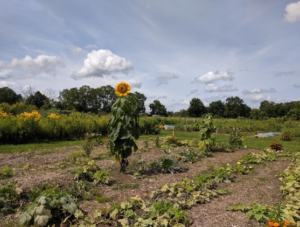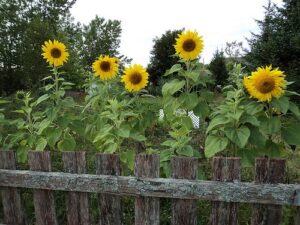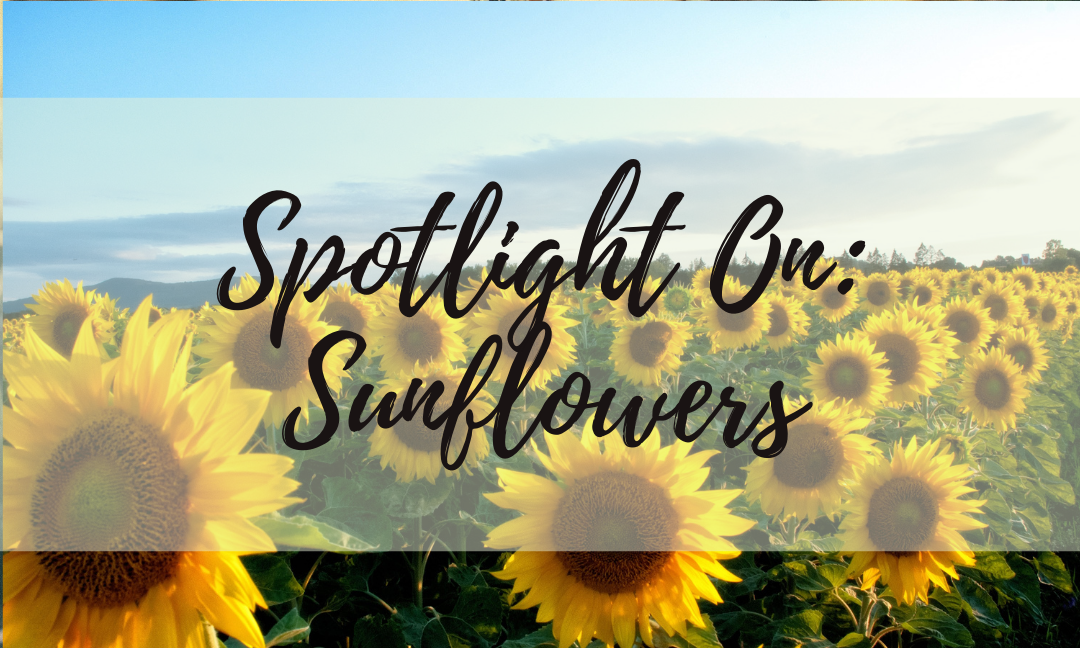Written by: Kiya Tavascia
 A sunflower is a large, daisy-like flower known for its beautiful look and edible seeds. It comes in many colours; red, orange, yellow, maroon, and brown but is commonly bright yellow. The flower head has anywhere from 15-30 petals and is 10-30 cm in diameter. The head of the flower rests on a green stem with many oval-shaped leaves all over. Did you know that the sunflowers stem can reach up to 15 feet tall? That’s like 3 of me stacked on top of each other! Sunflowers are annual plants that are most commonly used for cooking, bird seeds, and oils. Planted between March and mid-July, sunflowers are a fast-growing plant. It only takes 80-120 days. The planting and growing process is pretty easy. The first thing you should do is pick a spot in your garden with good soil. Plant the seeds 1-2 inches deep and 4-6 inches apart. You should give the plant plenty of room to sprout and grow so they can grow to their full potential.
A sunflower is a large, daisy-like flower known for its beautiful look and edible seeds. It comes in many colours; red, orange, yellow, maroon, and brown but is commonly bright yellow. The flower head has anywhere from 15-30 petals and is 10-30 cm in diameter. The head of the flower rests on a green stem with many oval-shaped leaves all over. Did you know that the sunflowers stem can reach up to 15 feet tall? That’s like 3 of me stacked on top of each other! Sunflowers are annual plants that are most commonly used for cooking, bird seeds, and oils. Planted between March and mid-July, sunflowers are a fast-growing plant. It only takes 80-120 days. The planting and growing process is pretty easy. The first thing you should do is pick a spot in your garden with good soil. Plant the seeds 1-2 inches deep and 4-6 inches apart. You should give the plant plenty of room to sprout and grow so they can grow to their full potential.
As to how to care for your sunflowers, there are not many things you need to do. Just water them heavily 1-2 times a week, make sure they have enough sunlight, and, of course, keep pests and wild animals away. It is amazing how easy it is to grow these flowers that I think are some of the most beautiful I’ve seen. There are many uses for sunflowers. You’ve probably indulged in a delicious bag of sunflower seeds while watching a baseball game one summer. Or maybe you’ve used sunflower oil as a healthier alternative. But other than eating them, sunflowers have other great benefits. They can create natural dye with their petals and are great for birdseed. Along with all of these benefits, they are also great decorations. If you ever need a quick present to bring to a friend or a cute way to decorate your house, sunflowers are a very beautiful and bright flower everyone will love(as long as they’re not allergic).



These bright-yellow, daisy-like flowers are easy to grow and have many different uses. Just plant them when it starts to get nice out and give them lots of water and sunlight. Then after 80-120 days look at your flowers! Then, you have many options of what you’re going to do with them. You could leave them in your garden to make it more colourful and fun. You could collect the seeds to eat or turn them into oil. Or, you could even bring them to a friend as a gift. No matter what you choose to do with them, I think you will have a great experience growing them and learning about this pleasant-looking flower.
Sources:
https://plantvillage.psu.edu/topics/sunflower/infos/diseases_and_pests_description_uses_propagation https://www.almanac.com/plant/sunflowers
https://www.sunflowerjoy.com/2016/06/what-sunflowers-used-uses-benefits.html

